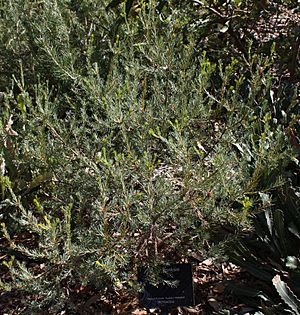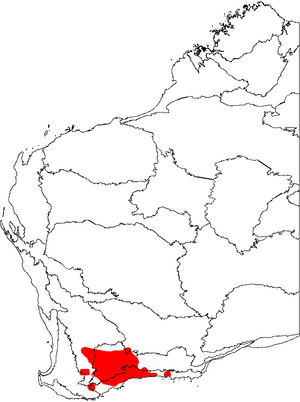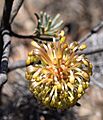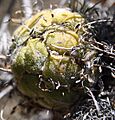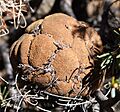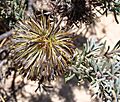Violet banksia facts for kids
Quick facts for kids Violet banksia |
|
|---|---|
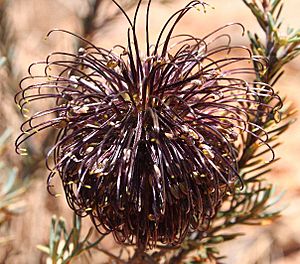 |
|
| Inflorescence of Banksia violacea | |
| Scientific classification | |
| Kingdom: | |
| (unranked): | |
| (unranked): | |
| Order: | |
| Family: | |
| Genus: | |
| Species: |
B. violacea
|
| Binomial name | |
| Banksia violacea C.A.Gardner
|
|
The Violet Banksia (Banksia violacea) is a special type of shrub or small tree. It belongs to the Banksia plant family. This plant usually grows as a small shrub, reaching about 1.5 meters (5 feet) tall. It has thin, narrow leaves. What makes it really stand out are its amazing dark purple flowers. These flowers are quite unusual for a Banksia!
You can tell the Violet Banksia apart from other plants by its unique flower color, short leaves, and flat seed pods. These pods are a bit sticky when they are young. This plant grows in low shrubland areas in southern Western Australia. You can find it from Esperance in the east to Narrogin in the west. It only grows in sandy soils.
The Violet Banksia was first described in 1927 by a botanist named Charles Gardner. For a while, some people thought it was just a type of B. sphaerocarpa. But now, it's known as its own species. There are no different types or varieties of the Violet Banksia, but some plants have a special woody base called a lignotuber, while others don't. Small insects like wasps, ants, and flies have been seen visiting its flowers. The Violet Banksia is not considered endangered in Western Australia. It's rarely grown by people because its flowers are often hidden.
Contents
What the Violet Banksia Looks Like
The Violet Banksia grows as a shrub, usually up to 1.5 meters (5 feet) tall. Its leaves are narrow, about 1 to 2 centimeters (0.4 to 0.8 inches) long and very thin. New parts of the plant grow in the summer. The plant usually flowers from November to April, with the most flowers appearing in February. However, it can flower at other times too.
The flowers grow in special Banksia "flower spikes". These spikes are round, about 2 to 3 centimeters (0.8 to 1.2 inches) wide. They are made of hundreds of tiny flowers packed closely together in a spiral shape. These flower spikes grow from the side stems and are often partly hidden by the leaves.
Most Banksia flowers are yellow or orange, but the Violet Banksia's flowers are often a beautiful violet color. Some can be very dark, almost black-violet, while others might be a mix of violet and greenish-yellow. Each tiny flower has a tube-shaped part and a long, thin style. The styles are hooked and break free when the flower opens. As the flowers get older, they slowly turn brown.
After flowering, the plant forms a woody "cone" with seed pods called follicles. These pods look hairy because the old flower parts stay on them. The pods are crowded around the round spike and are oval or diamond-shaped. They are about 1 to 2.5 centimeters (0.4 to 1 inch) long. They are quite flat and don't have a ridge. When they are young, the pods are green and a little sticky, covered in fine white hairs. As they get older, they turn tan or grey.
These pods open up after a bushfire, releasing winged seeds. The seeds are wedge-shaped and about 2 to 2.5 centimeters (0.8 to 1 inch) long. The seed itself is dark grey and crescent-shaped, with a flat, dark brown wing.
When a Violet Banksia seedling first grows, it has bright green leaves that are oblong. These first leaves are about 1.5 centimeters (0.6 inches) long. The stem of a young plant is hairy and reddish-green. The seedling leaves are also hairy and grow close together. Young plants often start growing branches within their first year.
Where the Violet Banksia Lives
The Violet Banksia grows in the southern parts of Western Australia. You can find it from Woodanilling to Esperance, and as far north as Hyden. This area includes places like the Avon Wheatbelt, Esperance Plains, and Mallee regions.
It prefers white sandy soils, often on top of laterite, clay, or quartzite rock. It usually grows in heath and shrubland areas. It often grows near mallee eucalypts and another Banksia called Banksia sphaerocarpa var. caesia. The Violet Banksia is not considered a threatened species under Western Australia's Wildlife Conservation Act.
How the Violet Banksia Grows and Survives
Like most other plants in the Proteaceae family, the Violet Banksia has special roots called proteoid roots. These roots have many short, dense side roots that form a mat just under the leaf litter in the soil. These roots help the plant take in nutrients from soils that don't have much food, especially phosphorus. However, the Violet Banksia is very sensitive to a plant disease called Phytophthora cinnamomi dieback.
The Violet Banksia is one of the few Banksia species that can have two different ways of growing back after a fire. Some plants have a lignotuber, which is a woody swelling underground. This allows the plant to resprout from below the ground after a bushfire. Other plants don't have a lignotuber and rely on their seeds to grow new plants after a fire. Both types of plants release their seeds after a bushfire. This helps new seedlings grow in clear, fertile ground. Plants with lignotubers are better at surviving fires because the main plant isn't killed. Lignotuberous plants are usually found in the north-eastern areas, near Woodanilling.
Banksia flowerheads are usually visited by many different birds, mammals, and insects. However, for the Violet Banksia, only wasps, ants, and flies were seen visiting its flowers during studies in the 1980s.
Growing the Violet Banksia
The Violet Banksia is not often grown by people. It grows slowly and can become a bit messy as it gets older. It usually takes about four to five years for a plant to flower after it sprouts from a seed. Even though the flowers are a unique color, they are often small and hidden by the leaves, which makes them less popular for gardens.
You can lightly trim the plant, but don't cut below the green leaves. However, if the plant has a lignotuber, you can prune it more heavily. Experts suggest planting it in a sunny spot with light, sandy soil. Some people think it's not very useful for growing flowers to sell because the flowers are small and hidden. However, its purple color could be useful for creating new plant types through plant breeding. The seeds don't need any special treatment and usually take between 19 and 50 days to germinate.
Images for kids


